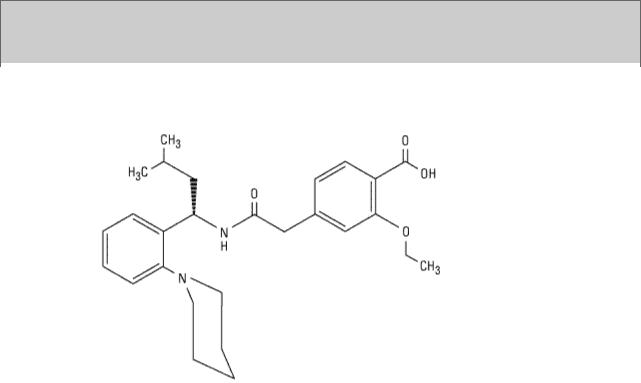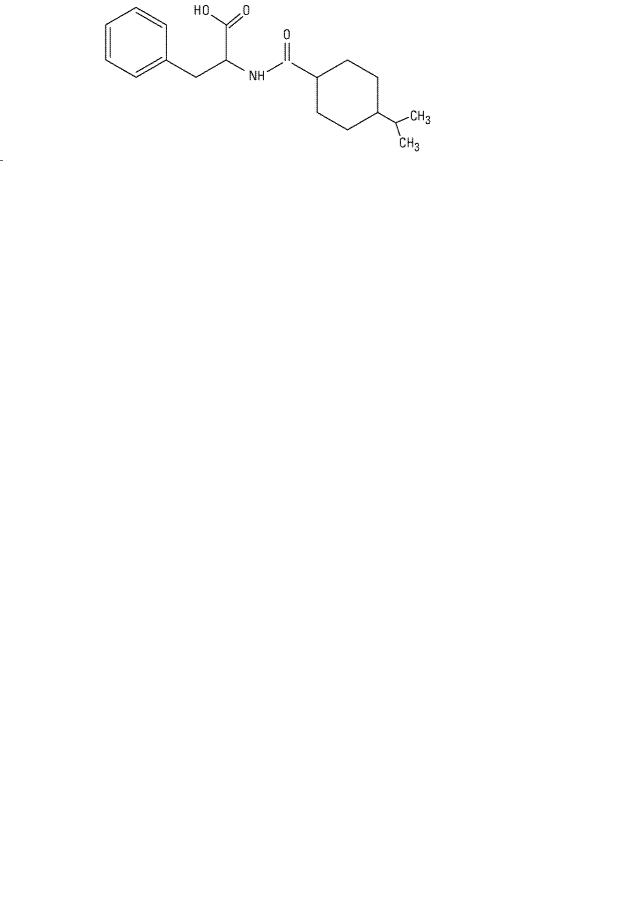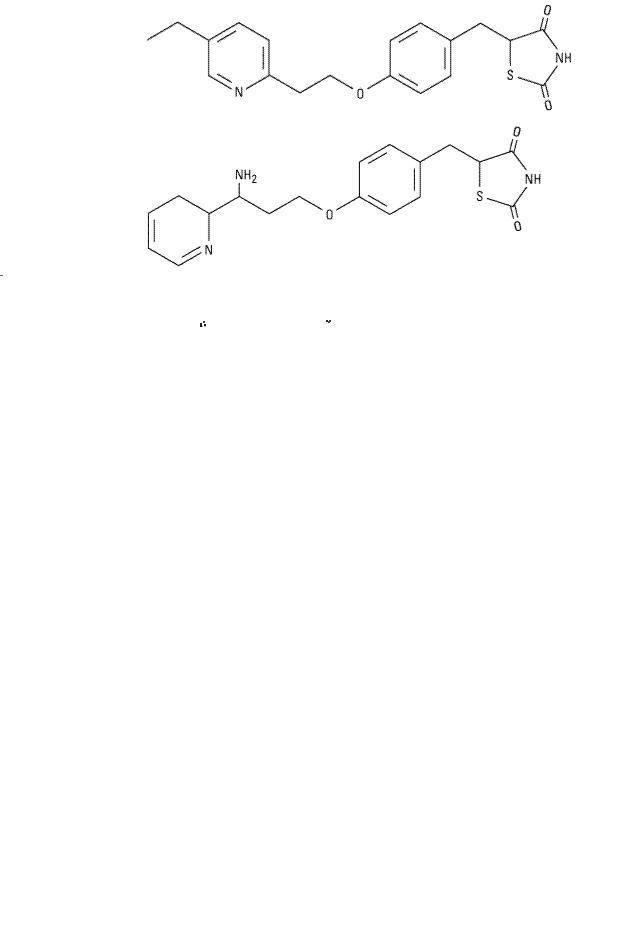
Книги фарма 2 / Bertram G. Katzung-Basic & Clinical Pharmacology(9th Edition)
.pdfdicumarol, phenylbutazone, some sulfonamides) that inhibit the metabolism of tolbutamide.
Chlorpropamide has a half-life of 32 hours and is slowly metabolized in the liver to products that retain some biologic activity; approximately 20–30% is excreted unchanged in the urine. Chlorpropamide also interacts with the drugs mentioned above that depend on hepatic oxidative catabolism, and it is contraindicated in patients with hepatic or renal insufficiency. Dosages in excess of 500 mg daily increase the risk of jaundice. The average maintenance dosage is 250 mg daily, given as a single dose in the morning. Prolonged hypoglycemic reactions are more common in elderly patients, and the drug is contraindicated in this group. Other side effects include a hyperemic flush after alcohol ingestion in genetically predisposed patients and dilutional hyponatremia. Hematologic toxicity (transient leukopenia, thrombocytopenia) occurs in less than 1% of patients.
Tolazamide is comparable to chlorpropamide in potency but has a shorter duration of action. Tolazamide is more slowly absorbed than the other sulfonylureas, and its effect on blood glucose does not appear for several hours. Its half-life is about 7 hours. Tolazamide is metabolized to several compounds that retain hypoglycemic effects. If more than 500 mg/d is required, the dose should be divided and given twice daily. Dosages larger than 1000 mg daily do not further improve the degree of blood glucose control.
Second-Generation Sulfonylureas
The second-generation sulfonylureas are more frequently prescribed in the USA than the firstgeneration agents because they have fewer adverse effects and drug interactions. These potent sulfonylurea compounds—glyburide, glipizide, and glimepiride—should be used with caution in patients with cardiovascular disease or in elderly patients, in whom hypoglycemia would be especially dangerous.
Glyburide is metabolized in the liver into products with very low hypoglycemic activity. The usual starting dosage is 2.5 mg/d or less, and the average maintenance dosage is 5–10 mg/d given as a single morning dose; maintenance dosages higher than 20 mg/d are not recommended. A formulation of "micronized" glyburide (Glynase PresTab) is available in a variety of tablet sizes. However, there is some question as to its bioequivalence with nonmicronized formulations, and the FDA recommends careful monitoring to retitrate dosage when switching from standard glyburide doses or from other sulfonylurea drugs.
Glyburide has few adverse effects other than its potential for causing hypoglycemia. Flushing has rarely been reported after ethanol ingestion and the compound slightly enhances free water clearance. Glyburide is contraindicated in the presence of hepatic impairment and in patients with renal insufficiency.
Glipizide has the shortest half-life (2–4 hours) of the more potent agents. For maximum effect in reducing postprandial hyperglycemia, this agent should be ingested 30 minutes before breakfast, since absorption is delayed when the drug is taken with food. The recommended starting dosage is 5 mg/d, with up to 15 mg/d given as a single dose. When higher daily dosages are required, they should be divided and given before meals. The maximum total daily dosage recommended by the manufacturer is 40 mg/d, although some studies indicate that the maximum therapeutic effect is achieved by 15–20 mg of the drug. An extended-release preparation (Glucotrol XL) provides 24hour action after a once-daily morning dose (maximum of 20 mg/d). However, this formulation appears to have sacrificed its lower propensity for severe hypoglycemia compared with longeracting glyburide without showing any demonstrable therapeutic advantages over the latter (which

can be obtained as a generic drug).
Because of its shorter half-life, glipizide is much less likely than glyburide to produce serious hypoglycemia. At least 90% of glipizide is metabolized in the liver to inactive products, and 10% is excreted unchanged in the urine. Glipizide therapy is therefore contraindicated in patients with significant hepatic or renal impairment, who would therefore be at high risk for hypoglycemia.
Glimepiride is approved for once-daily use as monotherapy or in combination with insulin. Glimepiride achieves blood glucose lowering with the lowest dose of any sulfonylurea compound. A single daily dose of 1 mg has been shown to be effective, and the recommended maximal daily dose is 8 mg. It has a long duration of effect with a half-life of 5 hours, allowing once-daily dosing and thereby improving compliance. It is completely metabolized by the liver to inactive products.
Secondary Failure & Tachyphylaxis to Sulfonylureas
Secondary failure, ie, failure to maintain a good response to sulfonylurea therapy over the long term—remains a disconcerting problem in the management of type 2 diabetes. A progressive decrease in B cell mass, reduction in physical activity, decline in lean body mass, or increase in ectopic fat deposition in chronic type 2 diabetes also may contribute to secondary failure.
Insulin Secretagogues: Meglitinides
The meglitinides are a relatively new class of insulin secretagogues. Repaglinide, the first member of the group, was approved for clinical use in 1998 (Table 41–7). These drugs modulate B cell insulin release by regulating potassium efflux through the potassium channels previously discussed. There is overlap with the sulfonylureas in their molecular sites of action since the meglitinides have two binding sites in common with the sulfonylureas and one unique binding site. Unlike the sulfonylureas, they have no direct effect on insulin exocytosis.
Table 41–7. Other Insulin Secretagogues.
Drug |
Chemical Structure |
Oral |
t1/2 |
Duration of |
|
|
Dose |
|
Action |
|
|
|
|
(hours) |
|
|
|
|
|
Repaglinide |
|
0.25–4 |
1 |
4–5 |
(Prandin) |
|
mg |
hour |
|
|
|
before |
|
|
|
|
meals |
|
|
|
|
|
|
|
|
|
|
|
|

Nateglinide |
|
60–120 |
1 |
4 |
(Starlix) |
|
mg |
hour |
|
|
|
before |
|
|
|
|
meals |
|
|
|
|
|
|
|
|
|
|
|
|
Repaglinide has a very fast onset of action, with a peak concentration and peak effect within approximately 1 hour after ingestion, but the duration of action is 5–8 hours. It is hepatically cleared by CYP3A4 with a plasma half-life of 1 hour. Because of its rapid onset, repaglinide is indicated for use in controlling postprandial glucose excursions. The drug should be taken just before each meal in doses of 0.25–4 mg (maximum, 16 mg/d); hypoglycemia is a risk if the meal is delayed or skipped or contains inadequate carbohydrate. This drug should be used cautiously in individuals with renal and hepatic impairment. Repaglinide is approved as monotherapy or in combination with biguanides. There is no sulfur in its structure, so repaglinide may be used in type 2 diabetic individuals with sulfur or sulfonylurea allergy.
Insulin Secretagogue: D-Phenylalanine Derivative
Nateglinide, a D-phenylalanine derivative, is the latest insulin secretagogue to become clinically available. Nateglinide stimulates very rapid and transient release of insulin from B cells through closure of the ATP-sensitive K+ channel. It also partially restores initial insulin release in response to an intravenous glucose tolerance test. This may be a significant advantage of the drug because type 2 diabetes is associated with loss of this initial insulin response. The restoration of more normal insulin secretion may suppress glucagon release early in the meal and result in less endogenous or hepatic glucose production. Nateglinide may have a special role in the treatment of individuals with isolated postprandial hyperglycemia, but it has minimal effect on overnight or fasting glucose levels. It is efficacious when given alone or in combination with nonsecretagogue oral agents (such as metformin). In contrast to other insulin secretagogues, dose titration is not required.
Nateglinide is ingested just prior to meals. It is absorbed within 20 minutes after oral administration with a time to peak concentration of less than 1 hour and is hepatically metabolized by CYP2C9 and CYP3A4 with a half-life of 1.5 hours. The overall duration of action is less than 4 hours.
Nateglinide amplifies the insulin secretory response to a glucose load but has a markedly diminished effect in the presence of normoglycemia. The incidence of hypoglycemia may be the lowest of all the secretagogues, and it has the advantage of being safe in individuals with very reduced renal function.
Biguanides
The structure of metformin is shown below. Phenformin (an older biguanide) was discontinued in the USA because of its association with lactic acidosis and because there was no documentation of any long-term benefit from its use.

Mechanisms of Action
A full explanation of the biguanides' mechanism of action remains elusive. Their blood glucoselowering action does not depend on the presence of functioning pancreatic B cells. Patients with type 2 diabetes have considerably less fasting hyperglycemia as well as lower postprandial hyperglycemia after biguanides; however, hypoglycemia during biguanide therapy is essentially unknown. These agents are therefore more appropriately termed "euglycemic" agents. Currently proposed mechanisms of action include (1) direct stimulation of glycolysis in tissues, with increased glucose removal from blood; (2) reduced hepatic and renal gluconeogenesis; (3) slowing of glucose absorption from the gastrointestinal tract, with increased glucose to lactate conversion by enterocytes; and (4) reduction of plasma glucagon levels.
Metabolism & Excretion
Metformin has a half-life of 1.5–3 hours, is not bound to plasma proteins, is not metabolized, and is excreted by the kidneys as the active compound. As a consequence of metformin's blockade of gluconeogenesis, the drug may impair the hepatic metabolism of lactic acid. In patients with renal insufficiency, biguanides accumulate and thereby increase the risk of lactic acidosis, which appears to be a dose-related complication.
Clinical Use
Biguanides have been most often prescribed for patients whose hyperglycemia is due to ineffective insulin action, ie, insulin resistance syndrome. Because metformin is an insulin-sparing agent and does not increase weight or provoke hypoglycemia, it offers obvious advantages over insulin or sulfonylureas in treating hyperglycemia in such individuals. The UKPDS reported that metformin therapy decreases the risk of macrovascular as well as microvascular disease; this is in contrast to the other therapies, which only modified microvascular morbidity. Biguanides are also indicated for use in combination with insulin secretagogues or thiazolidinediones in type 2 diabetics in whom oral monotherapy is inadequate. Metformin is useful in the prevention of type 2 diabetes; the landmark Diabetes Prevention Program concluded that metformin is efficacious in preventing the new onset of type 2 diabetes in middle-aged, obese individuals with impaired glucose tolerance and fasting hyperglycemia. Interestingly, metformin did not prevent diabetes in older, leaner prediabetics.
The dosage of metformin is from 500 mg to a maximum of 2.55 g daily, with the lowest effective dose being recommended. A common schedule would be to begin with a single 500 mg tablet given with breakfast for several days. If this is tolerated without gastrointestinal discomfort and hyperglycemia persists, a second 500 mg tablet may be added with the evening meal. If further dose increases are required after 1 week, an additional 500 mg tablet can be added to be taken with the midday meal, or the larger (850 mg) tablet can be prescribed twice daily or even three times daily (the maximum recommended dosage) if needed. Dosage should always be divided, since ingestion of more than 1000 mg at any one time usually provokes significant gastrointestinal side effects.
Toxicities

The most frequent toxic effects of metformin are gastrointestinal (anorexia, nausea, vomiting, abdominal discomfort, diarrhea) and occur in up to 20% of patients. They are dose related, tend to occur at the onset of therapy, and are often transient. However, metformin may have to be discontinued in 3–5% of patients because of persistent diarrhea. Absorption of vitamin B12 appears to be reduced during long-term metformin therapy, and annual screening of serum vitamin B12 levels and red blood cell parameters has been encouraged by the manufacturer to determine the need for vitamin B12 injections. In the absence of hypoxia or renal or hepatic insufficiency, lactic acidosis is less common with metformin therapy than with phenformin therapy.
Biguanides are contraindicated in patients with renal disease, alcoholism, hepatic disease, or conditions predisposing to tissue anoxia (eg, chronic cardiopulmonary dysfunction), because of an increased risk of lactic acidosis induced by biguanide drugs in the presence of these diseases.
Thiazolidinediones
Thiazolidinediones (Tzds) act to decrease insulin resistance. Their primary action is the nuclear regulation of genes involved in glucose and lipid metabolism and adipocyte differentiation. Tzds are ligands of peroxisome proliferator-activated receptor-gamma (PPAR- ), part of the steroid and thyroid superfamily of nuclear receptors. These PPAR receptors are found in muscle, fat, and liver. PPARreceptors are complex and modulate the expression of the genes involved in lipid and glucose metabolism, insulin signal transduction, and adipocyte and other tissue differentiation. The available Tzds do not have identical clinical effects and new drug development will focus on defining PPAR effects and designing ligands that have selective action—much like the selective estrogen receptor ligands (see Chapter 40: The Gonadal Hormones & Inhibitors).
), part of the steroid and thyroid superfamily of nuclear receptors. These PPAR receptors are found in muscle, fat, and liver. PPARreceptors are complex and modulate the expression of the genes involved in lipid and glucose metabolism, insulin signal transduction, and adipocyte and other tissue differentiation. The available Tzds do not have identical clinical effects and new drug development will focus on defining PPAR effects and designing ligands that have selective action—much like the selective estrogen receptor ligands (see Chapter 40: The Gonadal Hormones & Inhibitors).
In addition to targeting adipocytes, myocytes, and hepatocytes, Tzds also have significant effects on vascular endothelium, the immune system, the ovaries, and tumor cells. Some of these responses may be independent of the PPAR- pathway.
pathway.
In persons with diabetes, a major site of Tzd action is adipose tissue, where the drug promotes glucose uptake and utilization and modulates synthesis of lipid hormones or cytokines and other proteins involved in energy regulation. Tzds also regulate adipocyte apoptosis and differentiation. Numerous other effects have been documented in animal studies but applicability to human tissues has yet to be determined.
Two thiazolidinediones are currently available: pioglitazone and rosiglitazone (Table 41–8). Their distinct side chains create differences in therapeutic action, metabolism, metabolite profile, and adverse effects. A third compound, troglitazone, was withdrawn from the market because of hepatic toxicity thought to be related to its side chain.
Table 41–8. Thiazolidinediones.
Thiazolidinedione |
Chemical Structure |
Oral |
|
|
Dose |
|
|
|

Pioglitazone |
|
15–45 |
(Actos) |
|
mg once |
|
|
daily |
|
|
|
|
|
|
Rosiglitazone |
|
2–8 mg |
(Avandia) |
|
once |
|
|
daily |
|
|
|
|
|
|
Pioglitazone may have PPAR-
 as well as PPAR-
as well as PPAR- activity. It is absorbed within 2 hours of ingestion; although food may delay uptake, total bioavailability is not affected. Pioglitazone is metabolized by CYP2C8 and CYP3A4 to active metabolites. The bioavailability of numerous other drugs also degraded by these enzymes may be affected by pioglitazone therapy, including estrogencontaining oral contraceptives; additional methods of contraception are advised. Pioglitazone may be taken once daily; the usual starting dose is 15–30 mg. The triglyceride lowering effect is more significant than that observed with rosiglitazone. Pioglitazone is approved as a monotherapy and in combination with metformin, sulfonylureas, and insulin for the treatment of type 2 diabetes.
activity. It is absorbed within 2 hours of ingestion; although food may delay uptake, total bioavailability is not affected. Pioglitazone is metabolized by CYP2C8 and CYP3A4 to active metabolites. The bioavailability of numerous other drugs also degraded by these enzymes may be affected by pioglitazone therapy, including estrogencontaining oral contraceptives; additional methods of contraception are advised. Pioglitazone may be taken once daily; the usual starting dose is 15–30 mg. The triglyceride lowering effect is more significant than that observed with rosiglitazone. Pioglitazone is approved as a monotherapy and in combination with metformin, sulfonylureas, and insulin for the treatment of type 2 diabetes.
Rosiglitazone is rapidly absorbed and highly protein bound. It is metabolized in the liver to minimally active metabolites, predominantly by CYP2C8 and to a lesser extent by CYP2C9. It is administered once or twice daily; 4–8 mg is the usual total dose. Rosiglitazone shares the common Tzd adverse effects but does not seem to have any significant drug interactions. The drug is approved for use in type 2 diabetes as monotherapy or in combination with a biguanide or sulfonylurea.
Tzds are considered "euglycemics" and are efficacious in about 70% of new users. The overall response is similar to sulfonylurea and biguanide monotherapy. Individuals experiencing secondary failure to other oral agents should benefit from the addition (rather than substitution) of a Tzd. Because their mechanism of action involves gene regulation, the Tzds have a slow onset and offset of activity over weeks or even months. Combination therapy with sulfonylureas and insulin can lead to hypoglycemia and may require dosage adjustment. Long-term therapy is associated with a drop in triglyceride levels and a slight rise in HDL and low-density lipoprotein (LDL) cholesterol values. An adverse effect common to both Tzds is fluid retention, which presents as a mild anemia and peripheral edema especially when used in combination with insulin or insulin secretagogues. Many users have a dose-related weight gain (average 1–3 kg), which may be fluid-related. These agents should not be used during pregnancy, in the presence of significant liver disease, or if there is a concurrent diagnosis of heart failure. Anovulatory women may resume ovulation and should be counseled on the increased risk of pregnancy. Because of the hepatotoxicity observed with troglitazone, the FDA continues to require regular monitoring of liver function tests for the first year after initiation of Tzd therapy. To date, hepatotoxicity has not been associated with rosiglitazone or pioglitazone.
Thiazolidinediones have a theoretical benefit in the prevention of type 2 diabetes. One study


to carbohydrate induces the expression of 
 -glucosidase in the jejunum and ileum, increasing distal small intestine glucose absorption and minimizing the passage of carbohydrate into the colon. Although not a problem with monotherapy or combination therapy with a biguanide, hypoglycemia may occur with concurrent sulfonylurea treatment. Hypoglycemia should be treated with glucose (dextrose) and not sucrose, whose breakdown may be blocked. These drugs are contraindicated in patients with inflammatory bowel disease or any intestinal condition that could be worsened by gas and distention. Because both miglitol and acarbose are absorbed from the gut, these medications should not be prescribed in individuals with renal impairment. Acarbose has been associated with reversible hepatic enzyme elevation and should be used with caution in the presence of hepatic disease.
-glucosidase in the jejunum and ileum, increasing distal small intestine glucose absorption and minimizing the passage of carbohydrate into the colon. Although not a problem with monotherapy or combination therapy with a biguanide, hypoglycemia may occur with concurrent sulfonylurea treatment. Hypoglycemia should be treated with glucose (dextrose) and not sucrose, whose breakdown may be blocked. These drugs are contraindicated in patients with inflammatory bowel disease or any intestinal condition that could be worsened by gas and distention. Because both miglitol and acarbose are absorbed from the gut, these medications should not be prescribed in individuals with renal impairment. Acarbose has been associated with reversible hepatic enzyme elevation and should be used with caution in the presence of hepatic disease.
The STOP-NIDDM trial demonstrated that 
 -glucosidase therapy in prediabetic individuals successfully prevented a significant number of new cases of type 2 diabetes and helped restore
-glucosidase therapy in prediabetic individuals successfully prevented a significant number of new cases of type 2 diabetes and helped restore  cell function. Diabetes prevention may become a further indication for this class of medications.
cell function. Diabetes prevention may become a further indication for this class of medications.
Combination Therapy with Oral Antidiabetic Agents & Insulin
Combination Therapy in Type 2 Diabetes Mellitus
Bedtime insulin has been suggested as an adjunct to oral antidiabetic therapy in patients with type 2 diabetes patients who have not responded to maximal oral therapy. Clinical practice has evolved to include sulfonylureas, meglitinides, D-phenylalanine derivatives, biguanides, thiazolidinediones, or 
 -glucosidase inhibitors given in conjunction with insulin.
-glucosidase inhibitors given in conjunction with insulin.
Individuals unable to achieve glycemic control with bedtime insulin as described above generally require full insulin replacement and multiple daily injections of insulin. Insulin secretagogues are redundant when an individual is receiving multiple daily insulin injections, but cases of severe insulin resistance may benefit from the addition of one of the biguanides, thiazolidinediones, or 
 - glucosidase inhibitors. In some cases, multiple oral agents have been required together with insulin. When oral agents are added to the regimen of someone already taking insulin, the blood glucose should be closely monitored and the insulin dosage decreased as needed to avoid hypoglycemia.
- glucosidase inhibitors. In some cases, multiple oral agents have been required together with insulin. When oral agents are added to the regimen of someone already taking insulin, the blood glucose should be closely monitored and the insulin dosage decreased as needed to avoid hypoglycemia.
Combination Therapy in Type 1 Diabetes Mellitus
There is no indication for combining insulin with insulin secretagogues (sulfonylureas, meglitinides, or D-phenylalanine derivatives) in individuals with type 1 diabetes. Type 1 diabetics with diets very high in starch may benefit from the addition of 
 -glucosidase inhibitors, but this is not typically practiced in the USA.
-glucosidase inhibitors, but this is not typically practiced in the USA.
Katzung PHARMACOLOGY, 9e > Section VII. Endocrine Drugs > Chapter 41. Pancreatic Hormones & Antidiabetic Drugs >
Glucagon
Chemistry & Metabolism
Glucagon is synthesized in the A cells of the pancreatic islets of Langerhans (see Table 41–1). Glucagon is a peptide—identical in all mammals—consisting of a single chain of 29 amino acids, with a molecular weight of 3485. Selective proteolytic cleavage converts a large precursor molecule of approximately 18,000 MW to glucagon. One of the precursor intermediates consists of a 69- amino-acid peptide called glicentin, which contains the glucagon sequence interposed between

peptide extensions.
Glucagon is extensively degraded in the liver and kidney as well as in plasma, and at its tissue receptor sites. Because of its rapid inactivation by plasma, chilling of the collecting tubes and addition of inhibitors of proteolytic enzymes are necessary when samples of blood are collected for immunoassay of circulating glucagon. Its half-life in plasma is between 3 and 6 minutes, which is similar to that of insulin.
"Gut Glucagon"
Glicentin immunoreactivity has been found in cells of the small intestine as well as in pancreatic A cells and in effluents of perfused pancreas. The intestinal cells secrete enteroglucagon, a family of glucagon-like peptides, of which glicentin is a member, along with glucagon-like peptides 1 and 2 (GLP-1 and GLP-2). Unlike the pancreatic A cell, these intestinal cells lack the enzymes to convert glucagon precursors to true glucagon by removing the carboxyl terminal extension from the molecule.
The function of the enteroglucagons has not been clarified, although smaller peptides can bind hepatic glucagon receptors where they exert partial activity. A derivative of the 37-amino-acid form of GLP-1 that lacks the first six amino acids (GLP-1[7–37]) is a potent stimulant of insulin release. It represents the predominant form of GLP in the human intestine and has been termed "insulinotropin." It has been considered as a potential therapeutic agent in type 2 diabetes. However, it requires continuous subcutaneous infusion to produce a sustained lowering of both fasting and postprandial hyperglycemia in type 2 diabetic patients; therefore, its clinical usefulness is limited.
Pharmacologic Effects of Glucagon
Metabolic Effects
The first six amino acids at the amino terminal of the glucagon molecule bind to specific receptors on liver cells. This leads to a Gs protein-linked increase in adenylyl cyclase activity and the production of cAMP, which facilitates catabolism of stored glycogen and increases gluconeogenesis and ketogenesis. The immediate pharmacologic result of glucagon infusion is to raise blood glucose at the expense of stored hepatic glycogen. There is no effect on skeletal muscle glycogen, presumably because of the lack of glucagon receptors on skeletal muscle. Pharmacologic amounts of glucagon cause release of insulin from normal pancreatic B cells, catecholamines from pheochromocytoma, and calcitonin from medullary carcinoma cells.
Cardiac Effects
Glucagon has a potent inotropic and chronotropic effect on the heart, mediated by the cAMP mechanism described above. Thus, it produces an effect very similar to that of  -adrenoceptor agonists without requiring functioning
-adrenoceptor agonists without requiring functioning  -receptors.
-receptors.
Effects on Smooth Muscle
Large doses of glucagon produce profound relaxation of the intestine. In contrast to the above effects of the peptide, this action on the intestine may be due to mechanisms other than adenylyl cyclase activation.

Clinical Uses
Severe Hypoglycemia
The major use of glucagon is for emergency treatment of severe hypoglycemic reactions in patients with type 1 diabetes when unconsciousness precludes oral feedings and use of intravenous glucose is not possible. Recombinant glucagon is currently available in 1 mg vials for parenteral use (Glucagon Emergency Kit). Nasal sprays have been developed for this purpose but have not yet received FDA approval.
Endocrine Diagnosis
Several tests use glucagon to diagnose endocrine disorders. In patients with type 1 diabetes mellitus, a standard test of pancreatic B cell secretory reserve utilizes 1 mg of glucagon administered as an intravenous bolus. Since insulin-treated patients develop circulating anti-insulin antibodies that interfere with radioimmunoassays of insulin, measurements of C-peptide are used to indicate B cell secretion.
Beta-Blocker Poisoning
Glucagon is sometimes useful for reversing the cardiac effects of an overdose of  -blocking agents because of its ability to increase cAMP production in the heart. However, it is not clinically useful in the treatment of cardiac failure.
-blocking agents because of its ability to increase cAMP production in the heart. However, it is not clinically useful in the treatment of cardiac failure.
Radiology of the Bowel
Glucagon has been used extensively in radiology as an aid to x-ray visualization of the bowel because of its ability to relax the intestine.
Adverse Reactions
Transient nausea and occasional vomiting can result from glucagon administration. These are generally mild, and glucagon is relatively free of severe adverse reactions.
Katzung PHARMACOLOGY, 9e > Section VII. Endocrine Drugs > Chapter 41. Pancreatic Hormones & Antidiabetic Drugs >
Islet Amyloid Polypeptide (Iapp, Amylin)
IAPP is a 37-amino-acid peptide originally derived from islet amyloid deposits in pancreas material from patients with long-standing type 2 diabetes or insulinomas. It is produced by pancreatic B cells, packaged within B cell granules in a concentration 1–2% that of insulin, and secreted in response to B cell secretagogues. Approximately one molecule of IAPP is released for every ten molecules of insulin. A physiologic effect has not been established; however, pharmacologic doses inhibit the action of insulin to promote muscle uptake of glucose. IAPP appears to be a member of the superfamily of neuroregulatory peptides, with 46% homology with the calcitonin gene-related peptide CGRP (see Chapter 17: Vasoactive Peptides). Whereas CGRP inhibits insulin secretion, this has not been demonstrated at physiologic concentrations of IAPP. Clinical trials have begun to evaluate IAPP and its analogs, eg, pramlintide, as adjuncts to insulin therapy in type 1 diabetic patients with recurrent episodes of severe insulin-induced hypoglycemia—episodes that are generally refractory to usual preventive measures.


 -amylase, and
-amylase, and 
 -glucosidases that are attached to the brush border of the intestinal cells.
-glucosidases that are attached to the brush border of the intestinal cells. 
 -glucosidases and reduce the postprandial digestion and absorption of starch and disaccharides. Miglitol differs structurally from acarbose and is six times more potent in inhibiting sucrase. Although the binding affinity of the two compounds differs, acarbose and miglitol both target the
-glucosidases and reduce the postprandial digestion and absorption of starch and disaccharides. Miglitol differs structurally from acarbose and is six times more potent in inhibiting sucrase. Although the binding affinity of the two compounds differs, acarbose and miglitol both target the 
 -glucosidases: sucrase, maltase, glycoamylase, dextranase. Miglitol alone has effects on isomaltase and on
-glucosidases: sucrase, maltase, glycoamylase, dextranase. Miglitol alone has effects on isomaltase and on 
 -glucosidases, which split
-glucosidases, which split 
 -linked sugars such as lactose. Acarbose alone has a small effect on
-linked sugars such as lactose. Acarbose alone has a small effect on  -amylase. The consequence of enzyme inhibition is to minimize upper intestinal digestion and defer digestion (and thus absorption) of the ingested starch and disaccharides to the distal small intestine, thereby lowering postmeal glycemic excursions as much as 45–60 mg/dL and creating an insulin-sparing effect. Monotherapy with these drugs is associated with a modest drop (0.5–1%) in glycohemoglobin levels and a 20–25 mg/dL fall in fasting glucose levels. They are FDA-approved for use in individuals with type 2 diabetes as monotherapy and in combination with sulfonylureas, where the glycemic effect is additive. Both acarbose and miglitol are taken in doses of 25–100 mg just prior to ingesting the first portion of each meal; therapy should be initiated with the lowest dose and slowly titrated upward.
-amylase. The consequence of enzyme inhibition is to minimize upper intestinal digestion and defer digestion (and thus absorption) of the ingested starch and disaccharides to the distal small intestine, thereby lowering postmeal glycemic excursions as much as 45–60 mg/dL and creating an insulin-sparing effect. Monotherapy with these drugs is associated with a modest drop (0.5–1%) in glycohemoglobin levels and a 20–25 mg/dL fall in fasting glucose levels. They are FDA-approved for use in individuals with type 2 diabetes as monotherapy and in combination with sulfonylureas, where the glycemic effect is additive. Both acarbose and miglitol are taken in doses of 25–100 mg just prior to ingesting the first portion of each meal; therapy should be initiated with the lowest dose and slowly titrated upward.